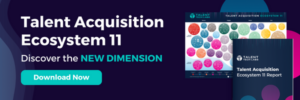This article previews excerpts from Talent Tech Labs’ Provider Insight Report about talent optimization platforms. SeekOut and TTL partnered to provide a webinar covering the same topic.
David Francis, Talent Tech Labs’ VP of Research & Product, was joined by Claire Fang, Chief Product Officer at SeekOut, to explore the latest in Talent Optimization Platforms in a webinar on November 17, 2022. They analyzed how Talent Optimization Platforms provide powerful insights into an organization’s talent pool and what you can do with that information. By watching this recorded webinar, you will learn how it can help improve recruiting performance across various metrics, leverage data to create better workforce planning strategies for your company, equip managers and talent leaders to make better decisions, and more.
Get the opportunity to learn more about this pivotal new category in talent technology and how you can leverage it to optimize your talent strategies by signing up to get access to the recording here.
The Emergence of A New Category: Talent Optimization
Today’s talent leader faces unprecedented challenges. They need to navigate and plan in an uncertain economy. They need to attract applicants in a candidate-driven and supply-constrained environment. They need to select top talent in an ever-changing market; they need to retain and grow their existing talent pool.
Talent leaders need to understand and be able to act on macro and micro talent market forces – what are the big shifts happening in the labor market? What are our competitors (direct and indirect) doing? What is happening at our organization and at our competitors’? Can we attract and retain the talent the organization needs to succeed?
@TalentTechLabs is excited to partner with @SeekOutHQ to provide more information about talent optimization. Check out some of their findings here: Click To TweetSolving these challenges has historically required a set of bespoke processes and technologies. Still, we are starting to see the emergence of tools and platforms that enable more holistic strategies across the talent continuum. These tools help organizations understand their current state and the state of the labor market, make informed strategic plans, and then act on those plans in a sourcing and talent management capacity. In this report, we analyze this emerging category – “Talent Optimization” – including what it is, the problems it solves, how to use it, and its potential for organizational impact.
Talent Optimization – Defining An Emerging Category
What is Talent Optimization, and why does it matter? Talent Optimization can be described as a holistic suite of data and AI-based applications designed to help empower various talent strategies, from planning to sourcing to talent planning, movement, and retention. Specifically, it is the combination of:
- Labor Market Intelligence (LMI) – real-time data on the external market and a company’s internal employees, including skills, candidate supply and demand, work history, talent flows, and demographics
- Matching System – an AI-based system for understanding and ranking individual candidate and employee capabilities versus open roles or opportunities
- Sourcing Capabilities – a system to act on LMI data to search, find, and hire or promote passive qualified candidates
- CRM and Candidate Engagement – tools to communicate with, market to, or nurture candidates at scale
- Internal Mobility / Employee Career Portal – tools for employers and employees to understand internal capabilities and skills, collaborate with peers, and optimize careers. Historically, these tools were designed for HR practitioners, not employees. Modern portals enable employee connection, ownership of data, and mentorship.
- Direct Hiring Manager View – enables managers to be a proactive part of the solution and have direct interaction with candidates and recruiters.
Why a New Category?
If many of the individual technologies that make up a Talent Optimization platform already exist (as described previously), why is there a need for a new category? The answer is that when a product comes to market that combines solutions in a new and novel way where the sum of its parts is fundamentally different from previous solutions, then a new category is often required.
Partnered with @SeekOutHQ, @TalentTechLabs is thrilled to provide a brand new insider report demystifying talent optimization. Check out the blog: Click To TweetAccording to Jesper Sørensen, Professor of Organizational Behavior at Stanford Graduate School of Business, “…genuinely novel products don’t fit neatly into one category or another. Indeed, their novelty stems from the very fact that the ideas and technologies that came together to create the new concept existed previously in domains or categories that were thought to be entirely distinct.”
In other words, new categories emerge when previously distinct technologies are brought together in new ways to solve problems in a fundamentally different way. In other words, when previously distinct technologies are brought together in new ways to solve problems in a fundamentally different way, new categories emerge.
The common thread of a Talent Optimization platform is a holistic suite of tools that uses lots of job and candidate data (enabled by artificial intelligence) to help organizations make informed decisions and execute talent strategies at scale.
Get access to the full provider insight report once it’s published. Before that, make sure you register to receive the recording of David Francis of TTL and Claire Fang of SeekOut as they dive headfirst into the emerging category of talent optimization. Sign up to receive your recording here!

